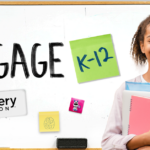Educational technology has been a transformative force in education. Its ability to support the differentiation of instruction, connect the outside world to what’s being taught in the classroom, and maintain the continuity of learning in the face of a worldwide pandemic are just a few of the ways education has revolutionized education.
Another way education technology is changing education is by improving equity and access. During the COVID-19 pandemic, the gaps in equity were starkly highlighted. Now, when I look to implement an educational technology tool with my students and staff, equity and accessibility are always at the forefront. I’ve identified five widely used edtech tools that include simple features that support improved equity and access.
Most of these tools are free or are very affordable. I love that these tools help remove barriers to learning and provide more equitable ways for students to access and engage with content. When I look back even over the past 5 years, utilizing some of these features would have either been extremely time consuming or too expensive to be a realistic part of your lessons. Now, since many of these features are built right into operating system, software, or via a website, they are right at the finger tips of your teachers and students.
Here are five equity and access tools built into common edtech resources you can begin using today:
Clips via Apple
Apple is known for the many accessibility features built right into their operating system. With vision, mobility, hearing and cognitive features, you can personalize your device and apps to meet your learning style. And with many of the apps that come with the iOS device, you can create and share content that is accessible to all.
One of my favorite apps that comes free with each iOS device is called Clips. When I first used this app, I felt it was similar to some of the other social media apps that included filters, fun fonts and stickers. It wasn’t until I dug in a bit more that I realized it had live titles (closed captioning) built right into the app. Yes, you heard that right. Any video you create using the app can immediately include your own live titles, aka closed captioning. What is even more impressive is that you can create live tiles in more than 60 different languages. This app is a lot of fun and an inclusive way to create digital content.
Discovery Education
Discovery Education is a global leader in standards-aligned digital curriculum resources, engaging content, and professional learning for K-12 classrooms. They have hundreds of ready-made lessons, quizzes and studio boards that utilize features such as closed captioning, immersive reader, self-paced activities and printable transcripts, to name a few.
These features help students because they are engaging, relevant and make content accessible to all. Teachers love these ready-made resources and rely on the components of the activities to build background knowledge, provide accessible content, extend their learning, and effectively assess student learning.
Flip via Microsoft
Flip, previously known as Flipgrid is a “video discussion app” that is free from Microsoft.
There are so many ways to empower students to share things that are important to them and what they are passionate about. A great introductory topic that is empowering for students is the opportunity to introduce themselves and share their preferred name and how to pronounce the name. Flip makes this fun and easy. And, If students are not ready to be on camera they can simply use the voice only feature.
Closed Captioning on YouTube via Google
Google has positioned itself as more than a search engine. There are many Google apps and extensions that make content more accessible. One feature that I encourage all to use is the closed captioning feature while playing YouTube videos. Did you know that there is now an auto-translate feature built right into Youtube. So, when you or your audience are watching a video, you can go to the settings, select subtitles and then auto translate from over 125 languages. We want to celebrate all the languages that our students speak, and we need to make certain our students and families are aware of these when we provide content that we share or post on Youtube.
Say “Hi” Translate via Amazon
I recently learned about Say “Hi” from our Multilingual Coordinator. This incredible app allows students to translate any text or speech into the language of their choice, which allows all learners to access language, including speech and text. My school district has 54 beautiful languages that are spoken by our students, yet our staff are not equipped to effectively communicate in all 54 languages. This is where this one app can remove communication barriers. The features of the app allow you to copy and paste the text that has been translated, speed or slow down the voice narration of the text and even access the content in different dialects of the language. Teachers can also type a message, and then hit play and have it heard in the language that is selected. This has opened so many opportunities for conversation and inclusion. This app is not limited to the classroom. There are endless opportunities and situations in which this can be used by all learners.
The incredible thing about technology is that it is ever changing. Successful companies are listening to educators and finding ways that all learners can access the content, engage in the material and express how they understand. I am grateful for all the new technology features, and the growing emphasis on making content accessible to all.

Rita Mortenson is the Educational Technology Coach for Verona Area High School, in Verona, Wisconsin. She is an ISTE Certified Educator, Discovery Education Leadership Council Member, Apple Distinguished Educator, Google Certified Innovator, and is a National Board Certified Teacher. She enjoys working and collaborating with staff and students to create opportunities for all.
The American Consortium for Equity in Education, publisher of the "Equity & Access" journal, celebrates and connects the educators, associations, community partners and industry leaders who are working to solve problems and create a more equitable environment for historically underserved pre K-12 students throughout the United States.
- American Consortium for Equity in Educationhttps://ace-ed.org/author/admin/
- American Consortium for Equity in Educationhttps://ace-ed.org/author/admin/April 23, 2025
- American Consortium for Equity in Educationhttps://ace-ed.org/author/admin/
- American Consortium for Equity in Educationhttps://ace-ed.org/author/admin/







